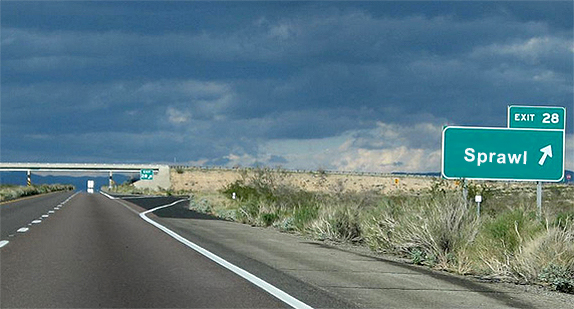
The Albuquerque region has been engaged in an epic growth battle for at least the past decade. Much of the struggle occurs in the city council chambers, in the county commission public hearings, and in water and air board meetings. The combatants are large landholders, property developers and businesses (think Chamber of Commerce and NAIOP) on one side, pitted against neighborhood activists, conservationists, smart businesses, planners and good government folks on the other.
One side wants business-as-usual (BAU) where the levers of public power can be manipulated for private gain. They eschew planning and growth management regulations in favor of backroom deals and handshakes. The future they envision includes sprawling subdivisions and ribbons of highways crisscrossing the Middle Rio Grande Valley.
The other side sees a very different future. The public is fighting for a more vibrant community core (downtown, uptown and within the established urban centers); they want public investments to focus on repair and maintenance of existing roads, water, sewer and other infrastructure; they believe city-county leaders should cooperate and coordinate with each other on development issues; they value local farms serving local tables, and they’re hoping for alternatives to the ticky-tacky rooftops as far as the eye can see (think the metropolitan Phoenix area).
The battle has played out on many fronts.
A regional plan (Focus 2050) was prepared in 2000 by the Mid-Region Council of Governments to provide a framework for building the future that the public envisioned. Focus 2050 is aspirational but has no teeth, and arguably hasn’t had much of an impact on local government decision-making.
In 2001, Albuquerque and Bernalillo County completed a four-year project called the Planned Growth Strategy. The PGS represented “a signal change in the direction of local government from its past practice of being reactive or accommodating to the initiatives of private developers to having a ‘different, more intentional approach to growth that.. .follows carefully considered principles,’ in the words of Town Hall participants.” The PGS made the BAU developers very nervous because it threatened to upend their special lock on the levers of power at city hall. Instead of backroom deals, the city might grow and flourish by implementing the community’s plan. Proactive, not reactive! The PGS represented a paradigm shift in how the region would grow. Chalk one up for the public. (More about the PGS later!)
After the PGS was completed, developers went on the offensive. In 2003, New Mexico Legislators supported the proposal by Bernalillo County and sprawl developers to disconnect the water utility system from Albuquerque’s control. City leaders were expressing concerns about extending water service lines to the far west side, but the BAU advocates knew if they could divide water and land use decisions, they’d have an easier time getting water service and so the Albuquerque-Bernalillo County Water Utility Authority (ABCWUA) was created. There’s never been a development proposed that the ABCWUA didn’t like. Water is no longer a constraint to the sprawl developers. Chalk one up for the BAU.
Sprawl developers fare much better when they can divide and conquer local governments. Later that same year (Nov. 2003), 61.5% of the voters rejected the city-county unification proposal on the ballot (Nov. 2003). Chalk another one up for the BAU.
Paying for growth has always been a huge bone of contention. The sprawl developers want to shift the risk and financial burden to the public as much as they can. The PGS included a revolutionary idea. Developers in the center of the city where all of the streets, water & sewer lines, parks, fire & police services already exist would pay little or no fees to build. On the other hand, developers on the fringe of the city where there are few public services and infrastructure would have to pay a lot more. Sprawl developers fought this idea tooth and nail at city hall and the state legislature. Soon after the PGS was adopted, city councilors passed impact fees based on this new paradigm, but the sprawl developers have been gradually undermining this program. In 2012, city councilors amended the impact fee program in line with their wishes, whittling the heart out of the PGS. Chalk another one up for the BAU developers.
The Tax Increment Development District Act (TIDDs) was another “win” for sprawl developers in 2006. State legislators, in their defense, probably didn’t understand the consequences of opening up this financing tool (traditionally used around the country for incentivizing redevelopment on contaminated brown fields) to subsidize sprawl development on green fields. Developers wanted the public to assume the financial risks for premature development. In 2008, SunCal developers proposed a massive new community on 55,000 acres on the Westside of Albuquerque. Their request to state legislators for $408 million in TIDDs failed on a tie vote in 2009, and the developer went belly-up (bankrupt) the following year. Chalk up several wins for the public.
Western Albuquerque Land Holding, LLC purchased SunCal’s property. WALH is requesting that Bernalillo County officials approve its Santolina Master Plan for sprawl development on 13,700 acres out near the Rio Puerco. Bernalillo County has always been more “developer-friendly” to unsustainable growth than the city. WALH knows how to play the game, and the public doesn’t have its eye on the ball in 2014.
The Bernalillo County Planning Commission will be considering the Santolina transportation plan on Wednesday, March 26 at 9 AM in the basement of the City-County Government Building.
(Image credit: Derived from photo by Ken Lund)

March 22, 2014